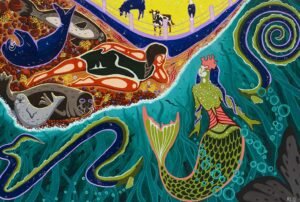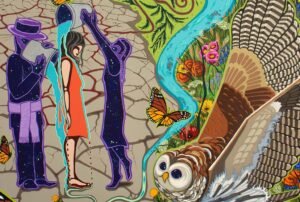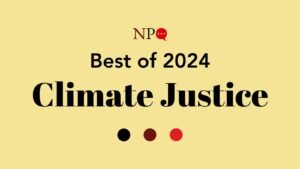
Editors’ note: This piece is from Nonprofit Quarterly Magazine’s fall 2024 issue, “Supporting the Youth Climate Justice Movement.”
In Parable of the Sower, Octavia E. Butler, a personal hero of mine who is beloved and celebrated by many, wrote:
All struggles
Are essentially
power struggles.
Who will rule,
Who will lead,
Who will define,
refine,
confine,
design,
Who will dominate.
All struggles
Are essentially
power struggles,
And most
are no more intellectual
than two rams
knocking their heads together.1
I have carried these words with me everywhere I go since first reading them. And as I get older, the words ring more and more true.
As a child growing up in Michigan, I attended a prestigious Catholic school on scholarship, which provided me with opportunities that were out of my parents’ financial reach at the time. I vividly remember every school morning suiting up in my blue plaid skirt, collared shirt, and sweater vest, and slipping on my saddle shoes. The drive to school overlooked a lake, and if you squinted, you could see Canada across the water. As we drove by, I daydreamed about the houses that rested on the state side and faced the water. Many of them were large estates with lawns and driveways the size of a traditional home. Many of my peers lived on those estates.
Sign up for our free newsletters
Subscribe to NPQ's newsletters to have our top stories delivered directly to your inbox.
By signing up, you agree to our privacy policy and terms of use, and to receive messages from NPQ and our partners.
We went on field trips all over the state of Michigan that I otherwise would not have had access to, which exposed me to pieces of history from which Black folks have been excluded. In the summers, the school put together various camps for students based on their age range. Older kids got to backpack part of the Appalachian Trail. I was always very envious of this. The one I begged my parents to let me go on was a five-day camping trip on Ohio’s Maumee River. They said yes.
Our Black community is interconnected not only through our history and our visions for a better future but also through the mountain ranges, creeks, rivers, swamps, streams, and plains of our shared planet.
I still don’t know how they scraped the money together. It was right after the 2008 recession, and gifts were strictly for Christmas and birthdays. This was my first time sleeping in a tent, horseback riding, brushing my teeth with bottled water, and seeing the stars without light pollution. And for many years, this was all I had. My outdoor experiences and education were small, and such rarified moments scattered across time were ones I have savored and carried with me through my life.
There was never an inherited belief that I could be a scientist or a person who could have an environmental impact. Maybe this alone was the inherited belief. Black children have been brought up in a system that perpetuates a predominantly White, heteronormative narrative around who stewards and cares for outdoor spaces. Science and environmentalism feel like modern-day Jim Crow career fields that systematically disenfranchise the very communities these fields often claim to protect and uplift: communities affected the most by climate disaster, food insecurity, homelessness, and lack of recreational outdoor access.
Black scientists, environmentalists, farmers, ranchers, and land stewards have inherited the additional responsibility of actively dismantling predominantly White environmental spaces; but navigating and dismantling such spaces adversely impacts our ability to do the work that we have truly envisioned for ourselves. How can we better create spaces for ourselves to do the work without White supremacy exacerbating and exhausting us to the point of burnout? Could resolving this question, alongside other questions we may feel a personal calling to answer, translate into more diverse representation for our environment, our communities, our ecosystems, and our climate?
Our Black community is interconnected not only through our history and our visions for a better future but also through the mountain ranges, creeks, rivers, swamps, streams, and plains of our shared planet. Maybe it’s this interconnectedness that empowers and amplifies us: we do not stand alone as individual ecosystems; we are a part of the profound web of life that surrounds us. Perhaps our activism can change when we think of ourselves as part of the overall ecosystem rather than separate from it.
It was in my later teenage years that I got bored with the White environmentalist narrative and began to challenge it. I had just relocated to Idaho after my parents’ divorce, and my mom had started a new job at a country music radio station. I’m not sure if it gets more Idaho than that. At first, I challenged the narrative in my own little personal ways. I was exploring my identity as a young person, freshly graduated from high school, who at the time was just barely beginning to grasp how vast this world is. I realized how much there was out there for me, and it didn’t matter to me anymore if I existed in ways that differed from what I viewed as Blackness. That internalized White supremacy was no longer something I could convince myself to carry, and so I began to try out things that “Black folks don’t do.”
Black folks know sorrow. We know loss. We know how it feels to be left out, forgotten, erased. And we know what it means to hurt. Now we need to remember joy.I learned to fish. I ran the toughest half-marathon in the Pacific Northwest. I learned about native plants and the Indigenous relationships to them. I went on a rafting trip. I hiked. I swam. I camped solo. And I laughed and danced through all of these moments. This fostered in me not only a love for the outdoors but also a deep and emotional relationship with this planet that facilitated and hosted all of my experiences.
I grew to be defensive and protective of my greatest teacher and host in this lifetime—our planet. Being outside has taught me about our interconnectedness and the dynamic realities of how loving this planet looks different for everyone. I learned, with my hands buried in the soil, how nature recognizes our joy and our sorrow. If you look closely between the headlines and performative gestures of sustainability, you can often catch glimpses of her sorrow, too. Even the trees become silent—they understand.
It is a huge responsibility to be an advocate for the environment. This vocation becomes even more complicated when your proximity to the environment has been systemically erased and you have been historically excluded from recreation outdoors. Many Black climate activists are healing the trauma of what we and our Ancestors have had to endure, while simultaneously advocating for a better world.
The importance of centering Black leadership in the climate justice movement boils down to love and to joy.
We are fighting against grind culture, heteronormativity, transphobia, and racial injustice in nearly every corner of our existence. Activism is healing for many of us. Fighting for a better world for ourselves, our communities, and the children of the future often inadvertently heals us. At the same time, we have been brought into a world where there’s either activism or complacency around a system that robs us of our joy, our brilliance, our uniqueness, and the importance of our story.
But to be complacent in the fight against climate injustice is a privilege that many of our communities do not have. Black folks know sorrow. We know loss. We know how it feels to be left out, forgotten, erased. And we know what it means to hurt.
Now we need to remember joy.
We need to think of our love.
People often protect and fight for what they love. This earth is our home, but it is also so much more. Our earth is a love story—and redefining how we are going to love is a crucial part of our liberation. Blackness in the climate justice movement means that we are reclaiming spaces from which we have been ostracized. Blackness in the climate justice movement means an expansion of the very definition of justice itself.
Note:
1. Octavia E. Butler, Parable of the Sower (Hachette Book Group, 1993), 94.












